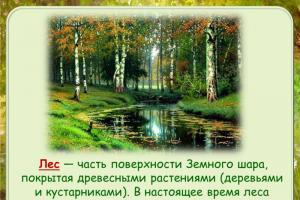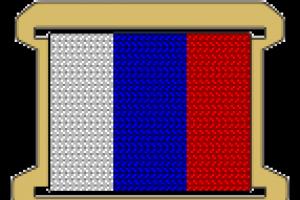What is it necessary to protect larch from and how to do it?
Larch is a type of wood often used in residential and utility construction, as well as in interior decoration. It is known as the densest and most durable of tree species: larch tolerates high moisture and all types of temperature influences well. A well-known example proving the strength of this material: the pillars of the foundations of houses in Venice, which are always under water, are made of larch, and remain unharmed for more than a thousand years.
However, does this mean that when building a house, laying a terrace or finishing a bathhouse, it is enough to simply lay larch without treating its surface with anything? Not at all. Modern protective compounds will help to avoid damage that threatens this material various reasons and extend its service life.
The main unfavorable factors for larch

Larch, which is used as external finishing or construction material: terrace board, facade finishing etc. The main reason for its possible damage is climatic factor. In our latitudes, the climate is characterized by sharp temperature changes, which, together with high air humidity, can cause damage.
So, in the summer, with high air humidity, the tree accumulates moisture- This usually happens at night. When the temperature begins to rise during the day, moisture quickly evaporates from the wood. If it evaporates from different layers of wood with at different speeds, this leads to warping of its surface and disruption of the geometry of the products.
IN winter time combination of moisture and cold also poses a danger. During a thaw, wood accumulates moisture, but when the air temperature drops sharply, the moisture in the wood structure begins to freeze and, accordingly, expand. This can cause cracks to appear in the wood, which will gradually increase.
Another unfavorable external factor for larch is ultraviolet radiation. The sun's rays cause the color of the wood to gradually change, it “fades” and becomes less attractive.
If larch is used as a finishing material for a bathhouse or sauna, it may suffer from frequent changes in humidity levels at elevated temperatures and, consequently, warping and cracking.
You should also take into account the risk of damage from mechanical loads, scratches from heels, animal claws, etc., especially if larch is used for flooring.
Hence, protective materials for larch must provide resistance against the following factors:
Mechanical influences;
Moisture penetration;
UV radiation.
Antiseptics for larch
Modern antiseptics provide protection against rotting and biological effects on wood (the appearance of mold, mildew, beetles), and also increase its hydrophobic properties, preventing the penetration of moisture. There are several forms of antiseptics, but the optimal ones for larch are formulations based on oil based. They are suitable for wood used both outside and indoors, as well as in saunas and baths. Oil compositions and impregnations create an elastic, durable film on the surface of the product and last for several years.
Antiseptics are applied to the surface of the wood using a brush or roller, preferably in two layers. Application by dipping is also possible, which is suitable for large volumes of wood.
It should be noted that materials that are connected to each other using a tongue-and-groove lock (lining, imitation timber, block house) only need to be processed front side and chamfers, provided there is a ventilation gap between the coating and the base. For materials such as decking boards, planks, etc., where there is a gap between the elements, processing on both sides is desirable.
UV protection

To provide protection from sun rays paints are used that can be transparent or opaque and change the color or tone of the wood. If you want to preserve the natural color of the wood, you can use modern oils that contain components that provide protection from UV rays without changing the color of the wood. However, it should be taken into account that such compositions need to be updated quite often - once every 2-3 years.
The choice of finishing materials, as a rule, is determined by their performance and aesthetic qualities, as well as price. What else is important to consider?
Why is thermopine more practical than ordinary larch?
After heat treatment, up to 95% of all resins and acids come out of pine. As a result of exposure to high temperatures, pine practically does not absorb or release moisture, due to which the finished product does not swell or dry out. The humidity of thermopine always remains at the level of 5-6%. The humidity of ordinary dry larch is from 11-16%. In this range, the board constantly changes its humidity, which means it changes its geometry and dimensions. Technological clearances between mounted boards decrease or increase. Longitudinal and transverse deformations complicate the finishing process.
Why can't larch be heat treated?
In Europe, not a single thermowood manufacturer works with larch. The resin pockets do not open completely after heat treatment, and long time resin may be released from already finished product. During external finishing, heat-treated larch changes geometry and delaminates: the upper layers of the material come off under the influence of the sun and humidity.
The best choice for finishing is thermowood!
The Thermowood-MGN company works only with high-quality materials, knowing how much a long service life of the finish means. We offer thermowood - a modern finishing material, characterized by a beautiful natural pattern, ease of processing and an affordable price.
The photographs show a facade made of ordinary dry larch of the Extra variety. A few months after installation, the boards picked up moisture from the atmosphere, causing their geometry to change significantly. The façade of the cottage required complete replacement.




When choosing products from natural wood It is important to pay attention to the essential factor. Namely, the degree of biological resistance of a particular wood, on which methods of protection against the rotting process depend.
According to the European standard, all biological factors affecting lumber can act in one of five situations:
- under the roof, with complete protection from moisture and weather conditions;
- under a roof, with protection from weather conditions, but with high humidity and short-term periodic wetting;
- on outdoors, but not in contact with the ground;
- in constant contact with fresh water or earth;
- in constant contact with sea water.
All of the above situations are simulated when studying the reaction of wood to destructive influences.
Biological resistance of larch wood
Siberian larch has increased biological resistance to decay, which is two times higher than that of pine. In accordance with the European standard EN 350-2:1994, this wood is classified as very resistant. Which is due to the specific combination of its inherent properties, such as:
- high density;
- increased resin content;
- special composition of gum.
The above provides larch wood with durability even when used in particularly difficult conditions. In particular, as a result of constant exposure to fresh and sea water, lumber from it not only does not begin to rot, but becomes even harder. A good example: the piles on which some of the houses of Venice have stood for hundreds of years.
It is the resistance of Siberian larch to decay, as well as other negative biological factors (wood-boring beetles, fungi), that allows the use of lumber from this type of wood when finishing areas near pools and reservoirs, for exterior finishing buildings and creating outdoor flooring (terraces, paths).
Propensity to rot: comparison of larch and oak
Resistance to rotting of any type of wood is assessed in relation to the biostability of linden, which was taken as one. Thus, the kernel of Siberian larch has a biostability index of 9.1 - the highest among tree species growing in Russia. And right behind it is oak wood, with a significant gap - its biostability is 5.2.
When comparing larch with oak, it is also important to know the hardness, mechanical strength and fire resistance of these species. In particular, the hardness of Siberian larch on the Brinell scale reaches 3.2 units, oak - 3.7. But at the same time, larch surpasses oak in mechanical strength and has higher fire resistance.
Ways to protect wood from rotting
 Despite the fact that lumber from Siberian larch itself is highly resistant to atmospheric conditions, some negative external factors (sudden temperature changes, high humidity, direct exposure to ultraviolet radiation) can lead to premature destruction of the wood.
Despite the fact that lumber from Siberian larch itself is highly resistant to atmospheric conditions, some negative external factors (sudden temperature changes, high humidity, direct exposure to ultraviolet radiation) can lead to premature destruction of the wood.
Accordingly, Siberian larch (and especially lumber that is used outdoors, such as decking) also needs special treatment from rotting using special antiseptic compounds. Such compositions can be of the following types:
- Oily. These include anthracene, coal, creosote and shale oils, which are resistant to water washout.
- Water soluble. Leachables - sodium fluoride, sodium silicofluoride, ammonium silicofluoride; difficult to wash out - sodium pentachlorophenolate, a mixture of zinc chloride and sodium bichromate.
- Organically soluble. These are predominantly compositions based on pentachlorophenol and copper naphthenate. They easily penetrate wooden surfaces, but have significant toxicity.
The choice of substance depends on the area of use of the products (for internal or exterior finishing) and the degree of exposure to negative environmental factors on them.
If you find an error in the text, select part of the text and press Ctrl+Enter
Larch is unique natural material, having mass useful characteristics and positive features, due to which wood of this species is often used in the construction of houses.
However, staircases made of larch are still quite a rare occurrence; experts consider this material not the most successful for finishing. But let’s be honest, it’s simply a pity for professional craftsmen to use such an excellent type of wood on stairs, but in vain, because structures made from this type of wood not only look good, but also have extraordinary endurance.
Larch is a material that is not afraid of water
It must be admitted that larch is really not afraid of water, but this is not its only unique property. It has a beautiful dense texture and rich color, thanks to which it goes well with different furniture and looks good in premium interiors.
Country house stairs made from this type of wood can be painted in different shades, starting from yellow and ending with dark brown. The last color signals that the structure is built from old wood, which, however, is not a drawback.
Prices for larch stairs are pleasing with their affordability. Due to its wide distribution in Siberia and Far East this raw material is supplied in abundance to manufacturers of all stripes. The average cost is $2500-3000, depending on the quality of the material and the complexity of the design.
Advantages and disadvantages
Dacha stairs made from larch, in addition to beauty and durability, have a number of advantages, the main of which are:
- resistance to humid environments: country stairs not only are they not afraid of water, but, on the contrary, when moisture gets on the wood fibers they become even stronger and more durable;
- resistance to rotting, especially after additional treatment with antiseptic agents;
- affordability.
Of the disadvantages that they have economy stairs, we can highlight:
- intractability in processing;
- susceptibility to cracking.
The last drawback is found quite often in larch structures, but it should not stop you from purchasing. Unlike wooden stairs from beech or oak, larch samples do not lose their positive properties after cracks appear and do not deteriorate externally.
Features of care
Considering that larch is not afraid of water, stairs made of this material can and should even be washed with a damp cloth, although you should not overdo it. Install next to heating appliances, as well as pine stairs, larch structures are not recommended to avoid cracking. From time to time, all glossy parts require treatment with special wax-based care compounds and thorough polishing.
Exploring the Sarmatian burial grounds of the Pazaryk culture (Altai, Bronze Age), our archaeologists constantly discover the frames of burial chambers built from larch logs; sarcophagi of representatives of the Sarmatian nobility, made from a single ridge of larch, and even war chariots, the parts of which were made from the same wood. At the same time, researchers are invariably amazed by the excellent preservation of larch products.
They did not forget about larch in later times, especially in those situations when there was a need for building structures capable of long service without loss of strength characteristics. In Venice in the Middle Ages and throughout the Renaissance, during the construction of residential and public buildings, the soil was strengthened with larch piles. It is believed that at least 400 thousand of these piles were used in this city. An interesting fact: a survey of the condition of these structures, carried out in 1827, showed that the wood not only did not collapse, but, on the contrary, gained even greater strength, so much so that the piles were difficult to give in to an ax or saw. It is also known that larch piles were used in the construction of St. Petersburg and Odessa. And here is another evidence of the incredible longevity of this tree: larch trunks that fell in the taiga back in the 18th century still have absolutely healthy wood.
It is quite obvious that amazing properties“Russian oak” deserve to get to know this most interesting representative of the plant world.
Let's start with the fact that today in our country larch justifiably claims to have a dominant position among all other species of industrial importance. In Russia, larch occupies the largest areas of 274 million hectares, which is about 40% of the total area of our forests, where 33% of all commercial timber reserves are concentrated. Despite the fact that this tree is found in most regions of our vast Motherland, the wood of the Siberian larch (Larix sibirica) is most valued. This is a large coniferous summer-green tree from the pine family. The diameter of the trunk at the butt can reach up to 2.5 m, and the height can reach 50 m. There is no reliable information regarding the maximum age to which this forest giant can live. However, there is information that in the Bratsk area there are still living trees that are more than 10 centuries old! For comparison: pine lives about 400 years.
Larch in general is an amazing tree in many ways. In particular, botanists classify this species as extremely light-loving plants. For example, linden is 9 times more shade-tolerant than larch. Larch's dependence on sunlight so large that in the dark the growth of the tree stops, unlike pine, which stubbornly stretches upward both day and night. Based on this, one could assume that larch grows approximately two times slower than its relative pine. In fact, everything turns out quite the opposite. The trunk of larch at 10 years of age reaches a height of 10 m, and its peer pine stretches only 2–5 m. This phenomenon is explained as follows: larch grows only on highly calcined soils. It is calcium that promotes such rapid growth of the tree. In addition, larch seeds ripen already in the first year of the tree’s life.
These two features explain the rare ability to reproduce characteristic of larch forests, which were never translated in Rus' and were called “leaf trees” from ancient times.
Now it’s time to move from popular educational information to a description of the practical properties of larch.
The first thing people usually notice is the incredible durability of wood, even under extreme operating conditions for products made from it. The reason for this vitality is gum, which is present in large quantities in wood and protects it from rotting. In accordance with the European standard EN 350-2:1994, larch belongs to the group of species that are very resistant to decay, and biostability increases with the age of the tree, and the most biostable wood is located in the butt part of the trunk. The resistance to rotting of wood of any species is assessed in relation to the biostability of linden, which is taken as one. The larch kernel has a biostability index of 9.1 - the highest among species growing in Russia. Immediately after larch, oak follows by a large margin - biostability 5.2.
Continuing to compare larch with oak, it should be noted that it is not much inferior to it in hardness. The Brinell hardness of larch wood is 3.2 versus 3.9 for oak. By the way, for pine this indicator does not exceed 2. Despite the fact that larch is somewhat softer than oak, it nevertheless surpasses it in mechanical strength. To verify this, just look at the end cut of a larch board or beam and examine the pattern of the transverse texture of the wood. The surprisingly dense “packing” of growth rings immediately catches your eye. In many cases, the distance between the dark “winter” and light “summer” rings does not exceed 1 mm! If we consider that the layers of wood that grow in winter consist mainly of resin, then it is easy to understand why larch has the highest strength properties and does not rot for centuries in water, soil, or air.
Another interesting property larch - relatively low flammability for wood. According to research conducted by specialists from the Moscow State University of Forestry, the fire resistance of larch is twice as high as that of pine wood.
Other advantages of larch include the high evenness of the trunk. Our ancestors long ago noticed that the trees that form larch pine trees are characterized by exceptional straightness, and in the 18th century it was understood that the larch tree is an almost ready-made ship mast. In 1738, by decision of the State Admiralty Board, a ship larch grove was laid out 60 miles from St. Petersburg “to create forests related to navigation.” Today, these straight-trunked giants form the famous Lindulovsky grove, each tree of which is specially registered and, like a person, has its own passport. The straightness of the tree is of great importance when processing wood: a higher percentage of yield of high-quality straight-grained lumber with minimal waste.
Scroll useful qualities larch would not be complete without mentioning healing properties its wood. It has long been noted that people living in houses built from larch suffer less from migraines, neuroses, hypertension and colds. Phytoncides released by wood have a beneficial effect on asthma, allergies, and diseases of the digestive system.

As you can see, larch is, in the full sense of the word, a unique creation of nature, and Alexey Aleksandrovich Polozov, a representative of the REAL WOOD group of forestry companies, will help us continue the conversation about this wonderful tree:
Indeed, nature itself gives us a universal building and finishing material, ideal for the harsh climate of Russia. The tree does not rot, and like bog oak, it tends to acquire additional strength in water, so larch products can be used for finishing the facades of houses and open verandas, constructing fences, and paving garden paths and, of course, as a structural material for building a house, especially since today timber and rounded logs are industrially made from larch. Something else is also important. Larch wood has a surprisingly beautiful texture pattern, and the color range includes up to 12 gradations. This means that larch can be successfully used for finishing interiors, including luxury ones.
Moreover, larch is superior to oak in terms of abrasion resistance, which makes it possible to make from it various materials for floor coverings: floorboards, parquet, skirting boards. By the way, the idea of producing larch parquet does not contain any novelty: such floors can be seen in the Ostankino Palace of the Sheremetevs.
- What larch wood products are produced by the REAL WOOD group of forestry companies?
To begin with, it should be said that the REAL WOOD group of forestry companies has existed for 5 years, and 3 years ago we opened a representative office in Moscow. Regarding our products, I would like to note that we process only Siberian pine and Siberian larch, and the range of materials we produce allows them to be used for finishing low-rise buildings. country houses, and city apartments.
If we talk about Siberian larch, then its wood has the greatest value. The highest performance qualities of this tree are largely due to the extreme conditions of its growth in the sharply continental climate of Siberia. All wood is harvested by us on our own plots in the Irkutsk region and transported to a procurement base owned by REAL WOOD, from where it is sent to the European part of Russia for processing. As for the assortment of our enterprise, it is represented by lumber intended for both interior and exterior decoration of the house and arrangement of the adjacent landscape area. For those who are interested in organizing a comfortable and aesthetically meaningful interior environment in their home, we offer a whole range of solid larch flooring.
It's wide and narrow batten, two types of parquet staves, massive parquet board, as well as a high plinth and a traditional “corner”. For finishing walls both inside and outside the house, we produce lining, narrow and medium width; universal board for walls and ceilings, as well as door frames. I would also like to draw attention to our products, which are aimed at long-term operation under conditions of negative impact external factors natural and climatic origin. First of all, this is planken - facade and fence cladding boards, deck and terrace boards for laying floors on open verandas and devices of stages of entrance groups.
- Why was larch practically not used in the woodworking industry in Soviet times?
I think this is due mainly to economic reasons. The fact is that transportation and processing of larch is associated with certain difficulties, which at that time did not in any way affect the purchase price of lumber from this wood. Then they reasoned like this: “needles” are “needles”, but what difference is it between larch and pine? Therefore, due to the specific economic policy, carried out in the Soviet era by the leadership of our country, and the special pricing system associated with it, it was more profitable to cut down and process pine. Now the situation is different: there is a very high demand for larch on the market and it is valued higher than pine, so harvesting and processing this wood has become profitable. In addition, larch forests have a high reproductive capacity, which ensures relatively rapid reproduction of industrial timber reserves.

- What makes up the cost of larch products today?
Let's start with transport costs. Nowadays, timber is almost never rafted, since rafting is due to large quantity"bottle" causes serious damage to the ecosystem of Siberian rivers. For this reason, larch has to be exported from the Siberian taiga using road, water and rail transport. But larch is a heavy tree, so by car, railway or by river transport it is transported in smaller quantities than the same pine. Another feature of larch is its very high natural humidity wood, so during drying it loses more volume than, say, pine. In addition, Siberian larch is “hot” in the climate middle zone, which explains its increased tendency to cracking. Consequently, larch requires a special drying regime.
There are other “little things”, such as, for example, the need to use saws with teeth made of hard alloys, the use of appropriate Supplies, preventing resin from accumulating between saw teeth, etc. All these and some other reasons determine the rather high cost of larch products in comparison with pine. At the same time, if we take into account the whole range of unique consumer properties inherent in this tree, then the price/quality ratio of larch will be more than preferable. Actually, this circumstance determines today’s colossal demand for larch in Europe.
What advice can you give to those who intend to use larch in the construction and decoration of their own home?
In our practice, there were cases when people built their houses entirely from larch. Of course, it’s good when financial capabilities allow you to acquire such a “treasure,” but you can still take the path of a more rational investment of funds, when only the two lower crowns and floor joists are made from larch, and the rest of the frame is made from Siberian pine. Such a house will last for centuries, of course, provided that it is properly designed and assembled. Considering that larch is susceptible to cracking, a longitudinal picking groove must be made in the timber or round timber, which is necessary to relieve stress in the wood. Despite the fact that such a groove does not always prevent the formation of cracks, its presence guarantees that the crack will not be through.
We usually give the following advice to buyers of larch parquet: after purchasing the parquet and delivering it to the site, it should remain in the room for 2-3 days in the original plastic packaging. Then the parquet needs to be released from the packaging and kept in this form for another two weeks and only after that begin installation. In addition, when choosing massive larch parquet, we recommend giving preference to a narrow plank - there is less chance of cracks forming. Preparation of the base for larch parquet does not have any specifics, but during installation, under no circumstances should water-containing adhesives be used. In addition, the larch parquet strip must be fixed to the base of the floor with a screw. Since larch is a prickly wood, the screw is screwed into the drilled hole. Of course, all this somewhat reduces the productivity of parquet work, but it ensures long-term maintenance-free operation of the floor.
Since larch does not rot, I recommend floors made of this wood for a Russian bath. At the same time, boards for the floor in the steam room should be chosen without knots and resin pockets: when high temperature resin will be released from them. In all other situations, knots may be present in floor covering from larch without compromising its performance. Speaking of bitches. For some reason, most of our compatriots believe that a tree grows without branches, and its wood should not have knots. Therefore, many Russians are initially focused on purchasing larch parquet, which does not have these, in their opinion, defects. But the problem is that when cutting even thick butt round timber, the yield of knot-free lumber does not exceed 25%. Hence the conclusion: the already expensive larch wood “overgrows” with an additional price only because it does not have knots.
In Europe the situation is completely different. People there don’t understand why they need to pay extra money, and are happy to buy larch parquet with knots, including for city apartments. Not only do Europeans save good money, in their opinion, the knotty floor only emphasizes its naturalness, and the dark “eyes”, contrasting with the overall tone of the floor, give the parquet an additional decorative effect. One more tip. Where larch products are used outdoors, it makes sense to take care of protecting the wood from ultraviolet radiation. Exposure to sunlight has no effect on technical specifications wood, but its visual qualities decrease over time: natural organic substances that color wood are not lightfast and gradually fade. I can’t say that all the recommendations I listed are related to the shortcomings of this tree.
These are not disadvantages, but rather features that are inherent in wood of any species, and they must be taken into account. Otherwise, larch is an excellent material, the high technical and aesthetic properties of which make it possible to solve a wide range of problems that arise during the construction and finishing of modern suburban housing.
Construction technologies 3(44)/2006








